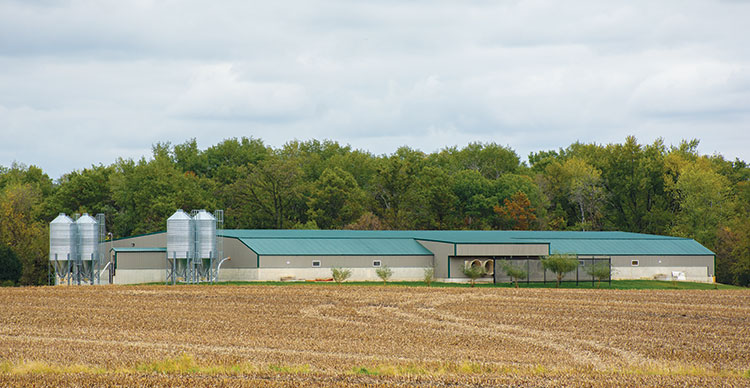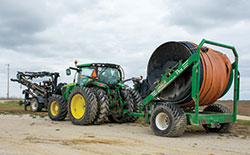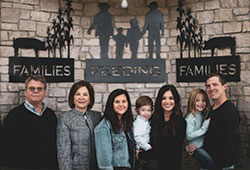
“Families Feeding Families” is the motto that emerged as Dale and Laura Reicks grew their hog operation from scratch. The husband-and-wife duo founded Reicks View Farms in 1979 with 240 acres of corn and 200 sows. The family-owned farm, which now includes their children Brady and Kaylie, has grown to 13,000 acres and 1.5 million hogs finished per year. With 300 employees, 130 production partners, and consumers across the country, the Reicks are certainly doing their part to feed families.
Sustainable practices have always been at the core of the farm’s growth. In fact, one of their company’s values is to be “clean and green.” Over the years, they have planted trees, added filtration systems to their barns, participated in a variety of recycling programs, and more recently, installed solar panels. And, since the very beginning, they have made sure to utilize the value of the manure produced by their livestock.
Reicks View Farms is headquartered in Lawler, Iowa. With Dale’s passion for architecture, their beautiful office serves as grand central station for the farm. At the main site is a sow barn, shop, and warehouse. This is also the location of their feed mill, which mixes nearly all the feed needed for their hogs, some 9,500 tons per week. There is storage for 2.8 million bushels of corn on site, and 400 semitruck loads of grain move in and out of the feed mill each week.

A map hanging on the wall shows every sow or finishing site owned or contracted by the farm. Rather than simply expanding at one location, they have spread out their hog facilities by purchasing nearby land as it became available. This allows them to generate manure close to the fields that can best utilize the nutrients.
“Dale has always understood the value of manure,” Demaray shared. “His philosophy has been that there’s a lot of value there, and we are going to try to capture as much as we can.” They strive to get the full benefit of the nutrients and build up fertility by banking it in the soil.
Today, they have 175 finishing barns that house 2,500 head each. They also work with more than 100 contract growers in northeast Iowa, including a few barns that Demaray owns himself, that finish hogs for the operation. In all, Reicks View Farms produces about 1% of the nation’s hogs.
The most recent expansion created enough space to hold over 60,000 sows. They currently have 11 sow units in operation, with a 12th under construction. They also own a boar stud and collect all their own semen. In addition, they raise gilts as a Pig Improvement Company (PIC) multiplier herd.
Hog production starts in the nursery, and they have room for 210,000 preweaned pigs at a time. While some farms may hire out this phase of production, it has been Dale’s philosophy that if they can get the pigs started on the right foot, and get them to feeder pig weight, that a majority of the hard work is already done.
Most of the company owned barns are “greenfield” facilities that they designed and built; it has not been their desire to purchase existing buildings. From the start, Dale said, “Let’s build our own,” and that has been a better long-term strategy for the farm, Demaray shared. Another division of Reicks View Farms is Jerico Construction, their own construction crew that builds facilities for the farm.
Like most any farm, labor is a great opportunity and a necessity. While the farm has good retention rates for employees, there is still a fair amount of turnover. “Pigs are easy, they do what they are supposed to do, but people are harder,” Demaray noted.
The Reicks are proud to provide employment options in their local community, and they feel that anyone willing to do manual labor can be trained to work in their barns. Most of their farrowing department is made up of women, as they have found them to have a more natural skillset for this area. They utilize Hispanic labor, and they have found these individuals to have good attitudes with a desire to learn and work hard. The farm is working on its first group of green card applications as another source of potential employees.
It has been more difficult to hire for their transportation unit, as Demaray said there are simply not enough CDL operators available. Transportation is a big part of their business, as they are moving 75,000 hogs every week. About 25,000 weaned pigs are moved out of the sow units, and 25,000 are moved out of the nursery to the finisher barns. Another 25,000 hogs are transported to market, with the majority of their hogs being sold to Tyson. Their location in Iowa places them close to several market options, which the Reicks consider a benefit to their operation.
With all this animal movement, they are washing and disinfecting 200 trailers a week. “It takes a lot of work and expense, but the benefits for animal health are worth it,” Demaray said of their commitment to biosecurity.
They recently built a new truck wash that includes six bays, more automation, and a floor with a 4-foot slope from the front of the trailer to the back that allows bedding and waste to be removed more easily. These new features maximize the farm’s biosecurity practices and reduce the amount of water required to get the job done.
Capturing the nutrients
When you have livestock, you have manure, and Demaray said, “We handle a lot of manure. It is a huge undertaking to manage.”
Manure accumulates in the underground storage beneath each barn. For the past five years, they have used a manure additive called Triune that prevents crusting in the stored manure and reduces odor. Working with Iowa State University researchers, air filtration systems that reduce both odor and ammonia emissions have also been incorporated in some of their newer barns.
The manure’s nutrient content varies depending on what facility it comes from. Manure from the sow units, for example, has a lower nutrient value due to the amount of wash water that also makes its way into storage, and as such, it must be applied to fields at a higher rate. The sow barn manure contains 10 to 15 units of nitrogen per 1,000 gallons, compared to manure from the finishing barns that has 40 units of nitrogen per 1,000 gallons.

They typically complete about 60% of their application in the fall and 40% in the spring. Dale prefers spring application as less nitrogen is lost, but it makes sense for their operation to empty the manure storages in both spring and fall, even though most of them have a years’ worth of capacity.
Demaray acknowledged that there are more costs associated with split application, but they are finding that visiting fields twice helps them do a more uniform job and cover some of the gaps.
“We are seeing a good yield response, so we are going to continue to do it,” he shared. A lower application rate also helps their fields to dry out more quickly in the spring, allowing their cropping crew to begin planting sooner.
The lead pump at the barn can push the manure a mile, and booster pumps are used when needed to go further than that. Before application, they work the perimeter of each field to help minimize any runoff.
Demaray said that prior to application season, they test their manure, sending more than 150 samples for laboratory analysis. Following their state’s requirements, they also take soil samples for analysis every four years. They use these results to determine what application rates and locations make the most sense.
“We want to determine where we are going to get the best bang for our buck with the manure we have,” Demaray said. “We try to be as efficient as we can, especially with the recent run up in commercial fertilizer prices.”
In hog country, most farms are in corn production year after year, which allows them to efficiently utilize their manure and produce the feed they need for their hogs. In all, the Reicks fertilize about 10,000 acres with manure, and they do nearly all the application themselves with their own equipment and a crew of four employees dedicated to nutrient management. Another staff member, with the help of an outside consultant, works to update close to 200 nutrient management plans each year.
Every facility has a manure management plan, and while these plans are a requirement to guide application, Demaray said the farm’s motivation to manage manure comes from capturing its value.
“We are regulated, but it’s the value of the manure that really drives more of that than the regulations,” Demaray shared. “It’s not just a cost of disposal for us; it’s really a co-product. It’s a very valuable by-product of producing pigs that we can fully utilize. The economics drive more decisions than regulations.”
Looking to the future
Demaray’s roots in agriculture were established by helping on his grandfather’s farm as a child. He said that was where he picked up his love of agriculture. After college, he got a job in the agriculture industry working as a lender for Farm Credit for nearly two decades. Over the years he saved some money to purchase land and put up a contract finishing barn. That generated equity, and he was able to buy another farm and grow his own side operation.
Through his work that specialized in swine farm lending, he met the Reicks. At the time, Dale was looking to add someone to their management team, and Demaray agreed. Since joining the company, he has also bought and rented more land and put up four additional contract barns, now raising hogs for Reicks View Farms. He sees his personal farm as an opportunity for him and his wife to instill in their three children a knowledge of farming and the value of hard work.
“It’s been fun for me to be able to do that, to grow my personal business, and at the same time, help grow the Reicks’ business,” Demaray noted.

“As we evaluated the solar installation, we found it to be a sustainable effort and a long-term investment in understanding renewable energy,” Demaray explained. “We liked it in part because it helps show that we want to be good stewards of the land, that we want to be as sustainable and renewable as we can, and that we are willing to try technology.”
Telling their story will be a priority for the farm’s future, too. The Reicks are very involved in their local community, and the siblings are focused on connecting with the “movable middle,” the people they feel are open to learning more about agriculture.
While manure handling isn’t always an easy story to tell, Demaray said that people find it interesting when they learn how their manure is utilized in a nearly closed loop system. With 2,500 head in each of their finisher barns and two groups finished per year, each barn houses 5,000 pigs. They share with the public that those animals produce enough manure to fertilize 160 acres.
With corn that yields around 200 bushels per acre, that manure fertilizes 32,000 bushels of corn. Each pig consumes about 6 bushels of corn, so most of the corn fertilized by the manure is fed to the next 5,000 hogs housed in that barn, and the cycle continues.
“When people hear that, they often say, ‘Whoa, that’s sustainable,’” Demaray explained. “It is pretty cool when people can make that connection.”
Community connections go beyond the farm, though. Many charitable donations are made annually to local groups and events as part of the Melissa Lea Reicks Foundation, a fund created in honor of Dale and Laura’s oldest daughter who tragically passed away in 2003. The Reicks also offer several college scholarships for students pursuing careers in agriculture. In 2020, during the early days of the COVID-19 pandemic, they donated 20,000 pounds of pork to community members and thousands of N-95 masks to a local hospital.
The motto “Families Feeding Families” really drives the daily operations of Reicks View Farms. Demaray emphasized that not only is the farm family owned, but many employees support their families by working here, and they have multiple members of the same family working for them.
“We are impacting others with this successful business,” Demaray said. “It is an economic engine that helps keep the community going.” With the next generation involved and a focus on sustainable agriculture in place, the Reicks are poised to remain a leader in both the hog industry and in their Iowa community for years to come.
This article appeared in the February 2022 issue of Journal of Nutrient Management on pages 12 through 15. Not a subscriber? Click to get the print magazine.








